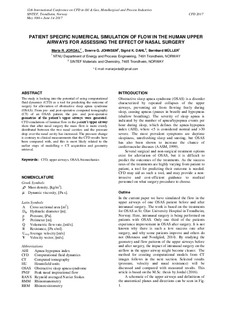| dc.contributor.author | Jordal, Maria Rolstad | |
| dc.contributor.author | Johnsen, Sverre Gullikstad | |
| dc.contributor.author | Dahl, Sigrid Kaarstad | |
| dc.contributor.author | Müller, Bernhard | |
| dc.date.accessioned | 2017-06-14T10:03:53Z | |
| dc.date.available | 2017-06-14T10:03:53Z | |
| dc.date.created | 2017-04-27T15:44:51Z | |
| dc.date.issued | 2017 | |
| dc.identifier.uri | http://hdl.handle.net/11250/2446006 | |
| dc.description.abstract | The study is looking into the potential of using computational fluid dynamics (CFD) as a tool for predicting the outcome of surgery for alleviation of obstructive sleep apnea syndrome (OSAS). From pre- and post-operative computed tomography (CT) of an OSAS patient, the pre- and post-operative geometries of the patient’s upper airways were generated. CFD simulations of laminar flow in the patient’s upper airway show that after nasal surgery the mass flow is more evenly distributed between the two nasal cavities and the pressure drop over the nasal cavity has increased. The pressure change is contrary to clinical measurements that the CFD results have been compared with, and this is most likely related to the earlier steps of modelling – CT acquisition and geometry retrieval. | |
| dc.language.iso | eng | |
| dc.title | Patient Specific Numerical Simulation of Flow in the Human Upper Airways for Assessing the Effect of Nasal Surgery | |
| dc.type | Lecture | |
| dc.description.version | acceptedVersion | |
| dc.identifier.cristin | 1467013 | |
| dc.relation.project | Norges forskningsråd: 231741 | |
| cristin.unitcode | 194,64,25,0 | |
| cristin.unitname | Institutt for energi- og prosessteknikk | |
| cristin.ispublished | true | |
| cristin.fulltext | postprint | |
